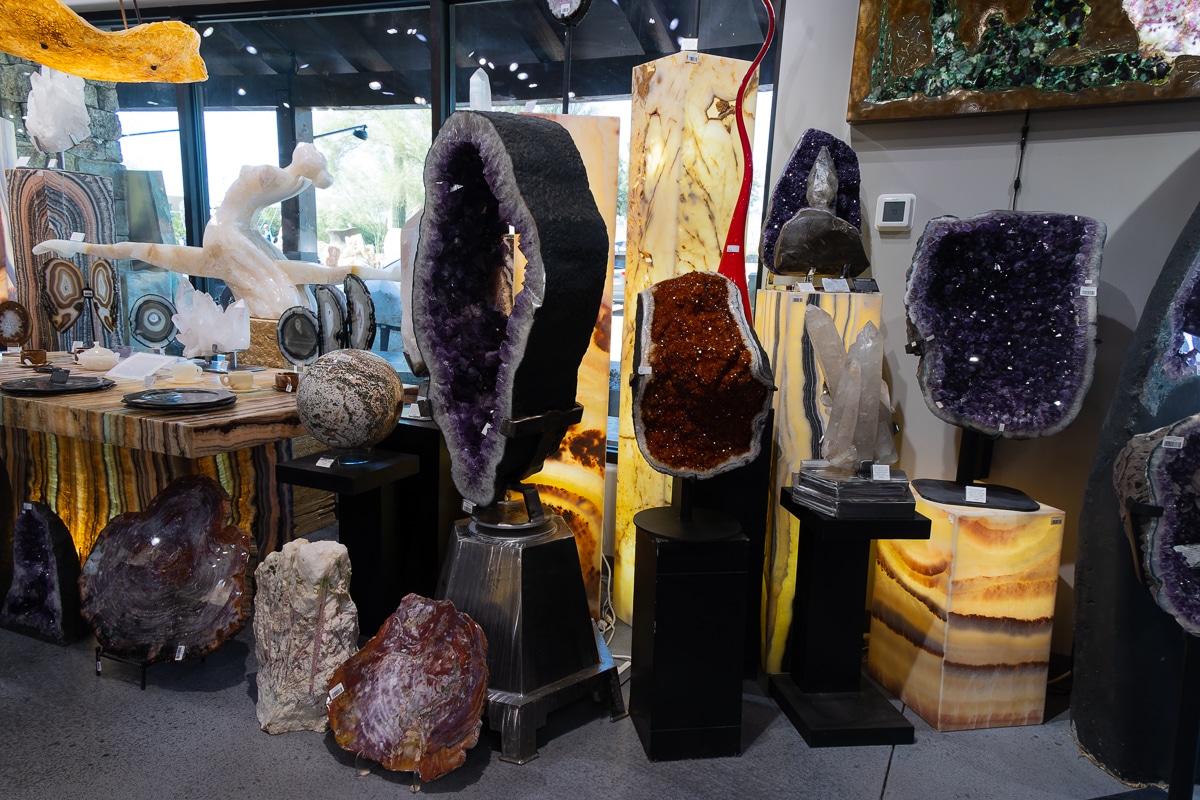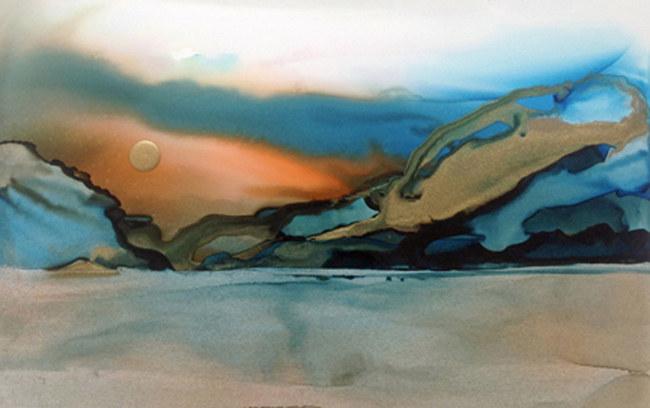8 Places to See Southwestern Art in Arizona

Arizona is a mecca for lovers of Southwestern art. Here are 8 places in Arizona To find paintings, Kachina dolls and ceramic pottery.
Arizona comes alive during the winter because our weather is much more sunny and beautiful than most other places in the U.S. and Canada. During this time of year, the population increases by almost 500,000 as people move south to escape the snow and ice. Many ask where they can find Southwestern art in Arizona. They are looking for copper wall hangings, handmade pottery, and authentic Kachina dolls. Join me on a journey through Arizona as I discover eight places where you can find amazing Southwestern art.
Tlaquepaque Arts and Crafts Village
The internationally renowned Tlaquepaque Arts and Crafts Village in Sedona is one of my favorite places to see Southwestern art. Tlaquepaque (pronounced tlah-kay-PAH’-kay) means “best of everything” in the Nahuatl Native language, the ancient language of the Aztecs. The name fits because Southwestern paintings, weavings, photography, ceramics, and bronze sculptures are displayed in more than 50 galleries. The village was originally an artist community, and you can often talk to local artists and see them at work.
The atmosphere at Tlaquepaque makes for a memorable experience. There’s a gorgeous courtyard around every corner, many with fountains, frescos, and brilliantly colored flowers. I find these beautiful vine-covered, stucco buildings and courtyards as interesting as the stores and galleries. With a setting this beautiful, many couples choose to have their wedding in the Tlaquepaque Chapel. You might hear the bells ring after a ceremony if you’re lucky.

The Tlaquepaque features beautiful vine-covered stucco buildings and courtyards. Photo by Marni Patterson
Desert Caballeros Western Museum
The first stop after Sedona was Wickenburg, the “most Western town in Arizona.” We stopped to see the Desert Caballeros Western Museum. This is an excellent place to view Southwestern art and historical exhibits celebrating the American West’s culture.
I was amazed by their collection of Remington bronze sculptures, Native American portraits by George Catlin, and Albert Bierstadt’s panoramic landscapes of the American West.
You can also see the life-size models of Wickenburg. These models depict life for pioneers and miners who settled in this region and displayed what day-to-day life was like for families that managed the many dude ranches that dominated the area.
I always plan a visit between March and September when the Desert Caballeros Western Museum hosts Cowgirl Up! This exhibit is a showcase for the best female artists who work in the Western genre. If you visit during the show dates, vote for your favorite artist.

The Cowgirl Up! exhibit at the Desert Caballeros Western Museum. Photo by Marni Patterson
Southwestern Art in Cave Creek
After leaving Wickenburg we traveled east until we reached quirky, eclectic Cave Creek just north of Phoenix. Our first stop was The Rare Earth Gallery, a rock and mineral store that could easily double as a museum. It’s billed as the “Eighth Wonder of the World,” and you’ll understand why when you see the unique and exotic geodes, crystals, and petrified wood on display. I always enjoy seeing exceptional sculptures, carved and polished stone furniture, and fossil and mineral collections.
Just down the road, Cimarron River Company features one-of-a-kind vintage pottery, hand-carved wooden bowls, collectible birds, and Hopi katsina (Kachina) dolls crafted by local Navajo, Zuni, and Hopi artists. Connie Miller, the owner and “Queen of Acquisitions,” purchases rare items directly from local Navajo, Zuni, and Hopi artists or from sources certified as authentic.

Kachina doll at the Cimarron River Company. Photo by Marni Patterson
I was particularly impressed with a large Kachina doll at the store entrance. It’s the result of two years of painstaking work by Chester Poleyestewa, a Hopi master carver whose work is sought after by collectors worldwide.
The Heard Museum: Indian and Southwestern Art in Arizona
We traveled to the heart of Phoenix at the Heard Museum to take a closer look into the intriguing world of American Indian art and culture.
Pro Tip #1: Talk to the docents and guides walking around the galleries. They represent Native American tribes throughout Arizona and can provide interesting perspectives about the exhibits.
The Heard Museum’s mission has 12 galleries full of traditional and contemporary art, several temporary exhibits, and an outdoor sculpture garden. You can easily spend an entire day immersed in American Indian art.
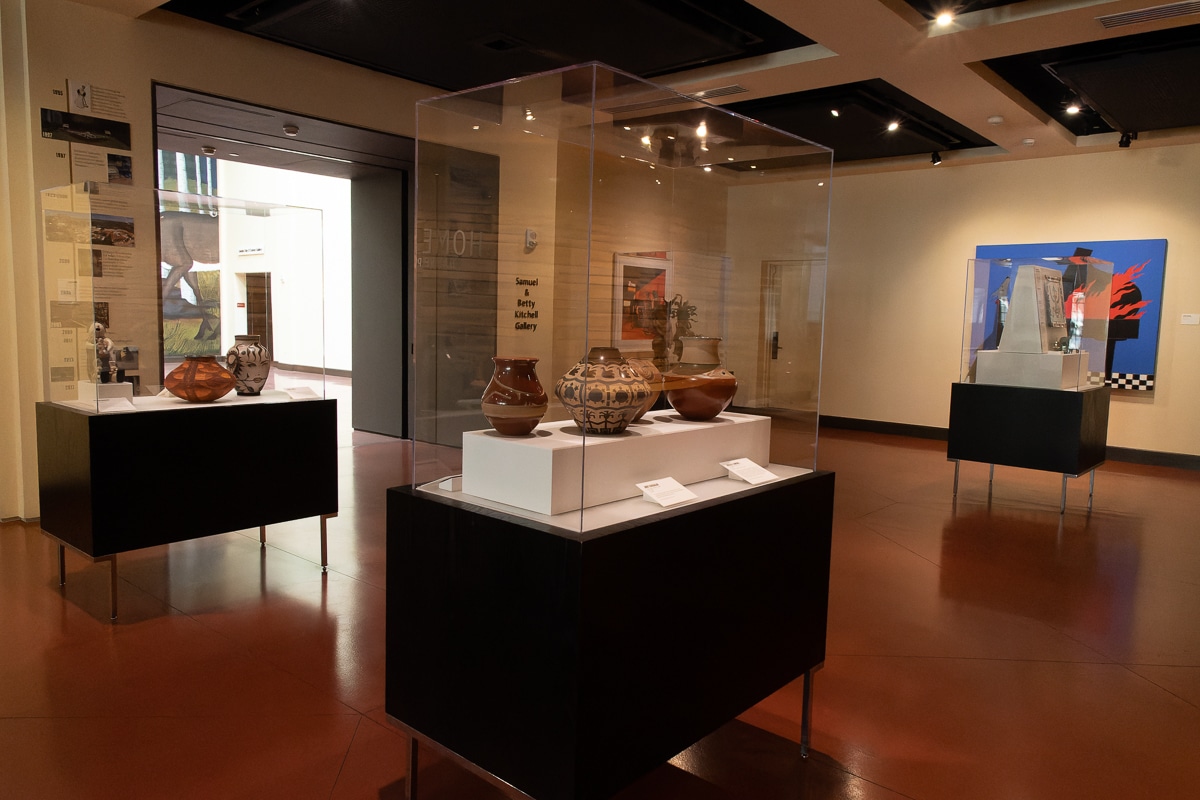
One of the 12 galleries at the Heard Museum. Photo by Marni Patterson
I liked all the exhibits and especially enjoyed the A.J. Dickey Gallery on the second floor. It contains pictures that show what it was like to attend an American Indian Boarding School.
Pro Tip #2: If you visit the Heard Museum Tuesday through Saturday, have lunch at the Courtyard Café. The menu includes salads, sandwiches and entrees that feature American Indian cuisine and all-natural ingredients that are sourced locally.
Scottsdale Art District
Next, we headed east to the Scottsdale Arts District in downtown Scottsdale. I love walking along Main Street because there are art galleries everywhere you look. I always stop in the galleries that display large-scale photography and copper wall décor. However, you’ll also see paintings, Native American jewelry, Navajo weavings, Hopi katsinas, and contemporary pottery.
At several galleries you can watch artists at work. One that I particularly enjoyed visiting was the On the Edge Gallery. It’s owned and operated by over 40 professional Arizona artists. You will see all types of Southwestern art on display, and if you’re lucky, you’ll get to speak with the artist who created the piece that caught your eye.

The On the Edge Gallery features the work of 40 professional Arizona artists. Photo by Marni Patterson
Pro Tip: Visit the Scottsdale Arts District on a Thursday evening to enjoy the weekly Scottsdale Art Walk. The galleries stay open until 10:00 pm and many feature artist demonstrations, exhibit openings, and live entertainment.
DeGrazia Gallery in the Sun
Our next stop was Southern Arizona in Tucson at the DeGrazia Gallery. Ettore (Ted) DeGrazia was an Arizona artist known for paintings and sculptures commemorating historical events and celebrating native Southwest cultures.
Pro Tip #1: Watch the short movie in the museum to learn more about DeGrazia and understand why he loved the Native American people he painted.

The De Grazia Gallery displays several Southwestern art collections. Photo by Marni Patterson
DeGrazia built the Gallery in the Sun in 1950 when he couldn’t find a gallery to represent him. It now displays six permanent and rotating collections that include over 15,000 works of art. I felt like I was traveling through Arizona history while strolling through rooms full of colorful paintings of Native American children, Southwestern landscapes, and other Western themes.
Pro Tip #2: Be sure to see the Mission in the Sun, the open-air chapel with rock floors, and interior murals DeGrazia built to honor Padre Kino.
Tubac, Where Southwestern Art in Arizona Meets History
After Tucson, we headed south to Tubac, a thriving artist community that, I was surprised to learn, had an exciting history.
Tubac was established in 1752 as a Spanish presidio and was the first Spanish colonial garrison in the territory. It was a stop on the Camino Real (“Royal Road”) from Mexico to Spanish settlements in California. In 1861 Apaches attacked it, and it was under siege for four days.
The town became an art colony between 1930 and 1960 and gained national recognition when a renowned painter opened what would become the Tubac School of Fine Art.
Tubac now includes over 100 galleries full of art, home décor, jewelry, and pottery. I had a wonderful time wandering in and out of galleries, talking to gallery owners about the artists they represent, and seeing artists at work.
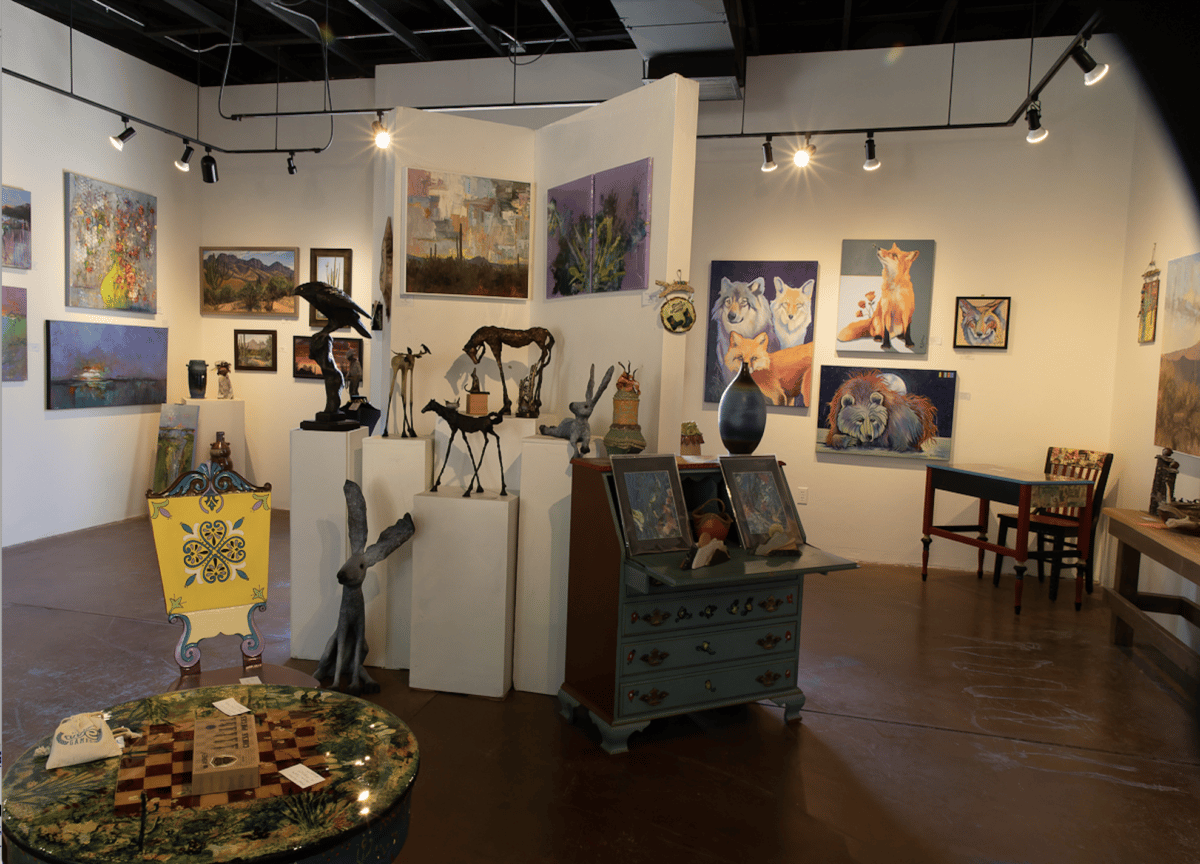
Tubac has over 100 galleries full of art, home décor, jewelry, and pottery. Photo by Marni Patterson
Don’t leave without visiting the Tubac Center of the Arts. It’s a large gallery in the center of town that hosts artistic events and artist workshops. It also offers opportunities for local artists to exhibit their work.
Bisbee, From Mining to Artist Haven
When we finished in Tubac, we went to Bisbee; a former mining town turned artist haven. In the 1800s Bisbee thrived on gold, silver, turquoise, and copper mining. I learned that Bisbee once produced 25% of the world’s copper and that it was the largest city in the Southwest between St Louis and San Francisco.
When the mine closed in the mid-1970s Bisbee “reinvented” itself as a funky artists’ colony with dozens of eclectic art galleries and some very creative street art. I enjoyed the galleries and was intrigued by the street art projects, including storefronts, murals, and even an entire building.
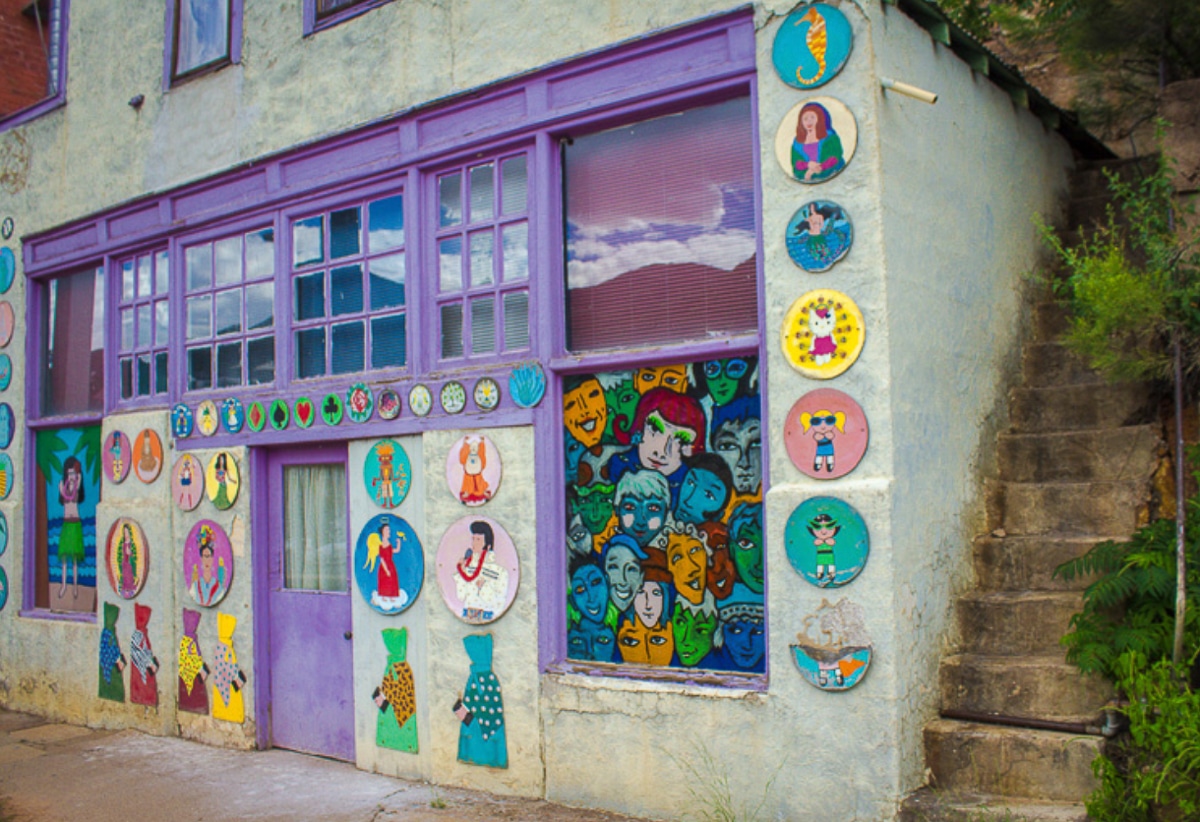
Bisbee has several art galleries and very creative street art. Photo by Marni Patterson
Pro Tip: Visit the Bisbee Mining and Historical Museum in the downtown area and the Lavender Pit Mine east of the town to learn more about the area’s history.
Articles Related to 8 Places to See Southwestern Art in Arizona
Plan Your Southwestern Art Trip
Whether you like sweeping desert landscapes, Navajo rugs, handmade pottery, or Kachina dolls, you’ll find it all in Arizona and across the Desert Southwest. When you plan your next trip to discover Southwestern art, be it in Arizona, New Mexico, or somewhere else on the globe, check out Wander for more ideas on what to see and do during your travels.

.

